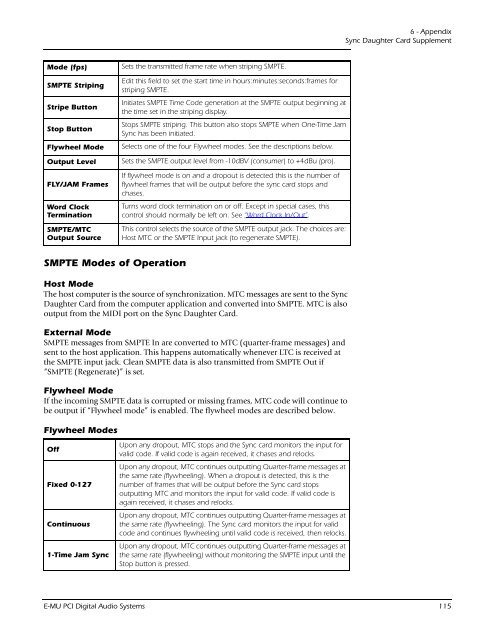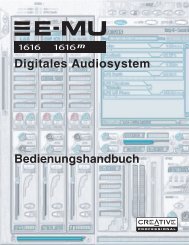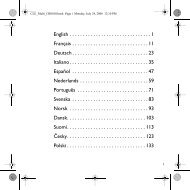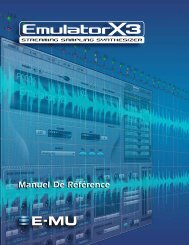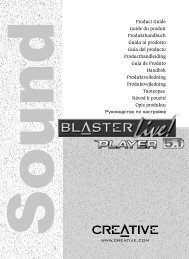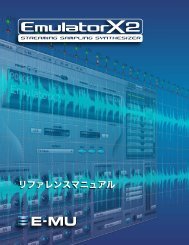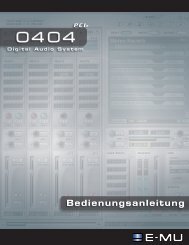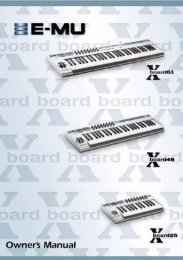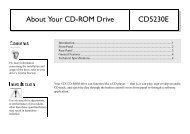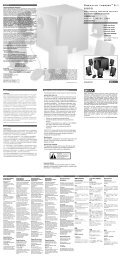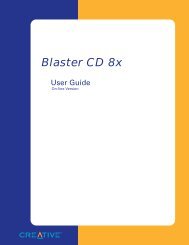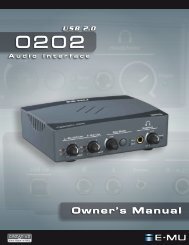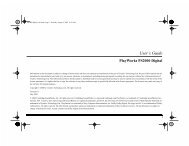Create successful ePaper yourself
Turn your PDF publications into a flip-book with our unique Google optimized e-Paper software.
Mode (fps)<br />
SMPTE Striping<br />
Stripe Button<br />
Stop Button<br />
Flywheel Mode<br />
Output Level<br />
FLY/JAM Frames<br />
Word Clock<br />
Termination<br />
SMPTE/MTC<br />
Output Source<br />
SMPTE Modes of Operation<br />
Sets the transmitted frame rate when striping SMPTE.<br />
Edit this field to set the start time in hours:minutes:seconds:frames for<br />
striping SMPTE.<br />
Initiates SMPTE Time Code generation at the SMPTE output beginning at<br />
the time set in the striping display.<br />
Stops SMPTE striping. This button also stops SMPTE when One-Time Jam<br />
Sync has been initiated.<br />
Selects one of the four Flywheel modes. See the descriptions below.<br />
Sets the SMPTE output level from -10dBV (consumer) to +4dBu (pro).<br />
If flywheel mode is on and a dropout is detected this is the number of<br />
flywheel frames that will be output before the sync card stops and<br />
chases.<br />
Turns word clock termination on or off. Except in special cases, this<br />
control should normally be left on. See “Word Clock In/Out”.<br />
This control selects the source of the SMPTE output jack. The choices are:<br />
Host MTC or the SMPTE <strong>Input</strong> jack (to regenerate SMPTE).<br />
Host Mode<br />
The host computer is the source of synchronization. MTC messages are sent to the Sync<br />
Daughter Card from the computer application and converted into SMPTE. MTC is also<br />
output from the MIDI port on the Sync Daughter Card.<br />
External Mode<br />
SMPTE messages from SMPTE In are converted to MTC (quarter-frame messages) and<br />
sent to the host application. This happens automatically whenever LTC is received at<br />
the SMPTE input jack. Clean SMPTE data is also transmitted from SMPTE Out if<br />
“SMPTE (Regenerate)” is set.<br />
Flywheel Mode<br />
If the incoming SMPTE data is corrupted or missing frames, MTC code will continue to<br />
be output if “Flywheel mode” is enabled. The flywheel modes are described below.<br />
Flywheel Modes<br />
Off<br />
Fixed 0-127<br />
Continuous<br />
1-Time Jam Sync<br />
Upon any dropout, MTC stops and the Sync card monitors the input for<br />
valid code. If valid code is again received, it chases and relocks.<br />
Upon any dropout, MTC continues outputting Quarter-frame messages at<br />
the same rate (flywheeling). When a dropout is detected, this is the<br />
number of frames that will be output before the Sync card stops<br />
outputting MTC and monitors the input for valid code. If valid code is<br />
again received, it chases and relocks.<br />
Upon any dropout, MTC continues outputting Quarter-frame messages at<br />
the same rate (flywheeling). The Sync card monitors the input for valid<br />
code and continues flywheeling until valid code is received, then relocks.<br />
Upon any dropout, MTC continues outputting Quarter-frame messages at<br />
the same rate (flywheeling) without monitoring the SMPTE input until the<br />
Stop button is pressed.<br />
6 - Appendix<br />
Sync Daughter Card Supplement<br />
E-MU PCI Digital Audio Systems 115


